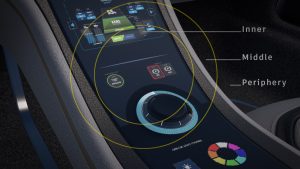Autodesk VRED Supports NVIDIA VRS and HTC VIVE Pro Eye to Maximize Quality in VR Design

Virtual reality (VR) technology is growing rapidly in the automotive industry. Designers want immersive visualizations that can accelerate iterations, saving time and money and improving the final product. For visualizations to be truly immersive, however, they must perform at VR-ready frame-rates and resolutions. This is a major computational challenge, given the demands of high-quality models and high-performance rendering.
One promising approach focuses rendering horsepower on those pixels designers care about most — namely, where they are looking and where complex materials must be faithfully reproduced. This technique is called variable rate shading (VRS). With the new VRED 2020.2 Beta, Autodesk VRED now supports NVIDIA VRS and HTC’s VIVE Pro Eye head-mounted display to take VR to the next level in automotive design.
For automotive designers, this VRS solution optimizes viewing performance. It provides higher image quality for specific materials, which is known as content-adaptive shading. It also produces higher-quality pixels only where the user is looking, which is known as foveated rendering. In both cases, VRS makes the design visually accurate by focusing computational power on areas of interest. For example, it augments instrument panels with subtle but critical details, such as material grain, metallic finishes, and text for UI controls.
For all of these reasons, VRS is fast becoming an industry standard. To date, it has two tiers of functionality. With basic Tier 1 VRS, it’s only possible to specify the shading rate based on the high-level geometry. NVIDIA RTX, however, is the world’s first architecture to support Tier 2 VRS, which allows precise control over the shading rate for different regions in the image.
We recently spoke with three VRS experts: Dr. Marko Savkovic, HTC Head of Product Marketing; Graham Breen, HTC Senior Manager B2B Solutions; and David Weinstein, NVIDIA Director of Virtual Reality. Together, they explained how this new VRS integration will benefit automotive designers.
How does VRED bring all of these offerings together?
Savkovic: VRED is the industry reference tool for design review, while VIVE Pro and VIVE Pro Eye are the most widely adopted VR solutions in large enterprises. And NVIDIA Quadro® GPUs are the industry standard for CAD modeling and visualization. We all share the same clients, especially in the automotive industry. Bringing best-in-class software and hardware together achieves a breakthrough by combining VIVE Pro Eye enterprise-grade VR with eye-tracking, the power of NVIDIA Quadro GPUs, and the design functionality of VRED.
What should VRED users be excited about?
Breen: VIVE Pro Eye precisely tracks the user’s gaze in real-time. This data is passed from the VIVE Pro Eye to VRED and then to NVIDIA VRS to optimize the rendering.
Weinstein: NVIDIA VRS uses the real-time eye-tracking data to constantly update a super-sampling mask for foveated rendering. That mask controls how many shader samples are used for each pixel. By increasing the number of shader samples in the pixels of the foveated region, we can dramatically increase the perceived image quality with only a small increase in rendering cost. And that cost can be offset by reducing the number of shader samples in the user’s peripheral vision, where the lower image quality won’t be noticed.
Breen: Eye-tracking also enables unique market research opportunities for automakers. For instance, designers could test the appeal of certain features of a car by measuring where virtual drivers spend their time looking.
How do the three products work together?
Savkovic: VIVE Pro Eye can be connected to a workstation by cable or a VIVE Wireless Adapter. RTX VRS provides foveated rendering by allocating different levels of GPU resources to focused areas and peripheral vision in real-time. During design meetings, participants can hop into VR and dive into the deepest of details with dual OLED displays that feature 615 PPI resolution.
What design challenges does this integration solve?
Breen: Making design decisions is difficult and expensive. But pairing this latest version of VRED with NVIDIA VRS offers an unparalleled level of VR realism. It accelerates the evaluation process and gives designers a new level of visual confidence.
Weinstein: With VRS, VIVE Pro Eye, and VRED, materials simply look more realistic. Carbon fiber, fabrics, and subtle textures now read with visual clarity.
Is VR the future of automotive design?
Savkovic: We believe that foveated rendering is just the beginning. Going forward, gaze control — using eyes for navigating VR without controllers — and eye-tracking related analytics will enable important use cases and valuable data to help the design process.
VRED is an industry-standard tool for automotive design visualization. Together with NVIDIA VRS and HTC VIVE Pro Eye, it allows designers to discover the full potential of VR and revolutionize the design process. Learn more about how VR and augmented reality are changing how automotive manufacturers bring new designs to life.
Written by:
John Papageorge
Automotive Marketing Manager

John is a product marketing manager at Autodesk. He has worked and consulted with some of the biggest names in technology, including Oracle, Cisco, Hewlett Packard, and IBM, to maximize their marketing strategies. John holds a Bachelor of Science in Engineering and Journalism from the University of Wisconsin-Madison.